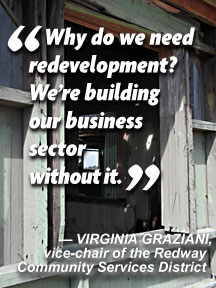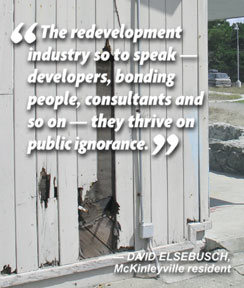|
 
COVER
STORY | IN THE NEWS | ART
BEAT
DIRT |
PREVIEW | THE HUM | CALENDAR
September 22, 2005

story & photos by BOB DORAN
A FEW MONTHS AGO, AT A WORKSHOP
CALLED BY COUNTY government's powers-that-be, Virginia Graziani,
vice-chair of the Redway Community Services District, was surprised
to learn that her own home -- a typical southern Humboldt house
in a typical southern Humboldt neighborhood -- was deemed an
eyesore.
It wasn't that a county official
took her aside to break the bad news to her. Rather, in a long
involved report put together to show the degree of "blight"
in various parts of the county, Graziani found her house and
her neighbors' cited as "deteriorated" dwellings, one
step above "dilapidated." Her abode was evidence that
the county needed to take action to combat squalor.
Noting that her house is in
"a really nice part of town," and not in bad shape,
Graziani could only guess at the criteria used to identify her
home, and her entire Redway neighborhood, as a "blighted
area."
"We don't have sidewalks,"
she said recently. "We don't have city street lighting.
There are streets close to us that are not paved. A few buildings
in the business district are in poor condition. There are a few
homes that are in poor condition. My neighbors are a retired
couple, and Virgil has an old car sitting in front of the house
that he hasn't gotten around to fixing. And their house could
use a coat of paint. Mine could too."
But for the county, apparently,
the case was more serious. Graziani's home, and others like it,
was evidence that Redway needed redevelopment.
For many Humboldt County residents,
it went unnoticed. In December 2002, the Humboldt County Board
of Supervisors passed an ordinance forming a Redevelopment Agency,
as the county puts it, "in response to the need for economic
development in deteriorating communities affected by the downturn
in the resource based industries."
Of course redevelopment is not
new. Eureka has had a plan in place since 1973. Arcata got in
on redevelopment in the '80s. Fortuna followed suit not long
after.
The Eureka Redevelopment
Agency is pulling in approximately $3.1 million annually through
what is termed tax increment financing. The typically low-profile
agency has been in the headlines more than usual of late because
a lawsuit brought by the Humboldt Taxpayers' League regarding
the award of contracts for two projects on the city's waterfront.
While the scrutiny of Eureka's
Redevelopment Agency and its advisory board have little to do
with the county's unfinished plan, more people seem to be paying
attention as the process set in motion in 2002 heads into the
home stretch.
In October, the county's Community
Development Services Department is slated to present the supervisors
with an updated redevelopment plan encompassing eight unincorporated
communities: Orick, Manila, Samoa-Fairhaven, Glendale, Fields
Landing, Alton and Redway.
If all goes well, the 45-year
plan could be adopted early in 2006. At that point the supervisors,
who also serve as the board for the redevelopment agency, would
entertain proposals for redevelopment projects. But there are
those who would like to stop the plan in its tracks, or at least
alter its course.
The community services district
boards in Redway and Manila have asked for an advisory vote to
determine if residents really want to be part of the plan. Meanwhile
vocal critics have been doing what they can to inject their contrary
opinions into the mix.
What is redevelopment?
"At one level redevelopment
is hugely simple, but at another level it's tremendously complex,"
said Kirk Girard, who, as the county's director of community
development services, serves as point man for the nascent plan.
"At the simple level, redevelopment is nothing more than
redirecting tax dollars to a community for infrastructure development."
California first adopted the
Community Redevelopment Law more than 50 years ago as part of
a nationwide "urban renewal" movement. Since then the
law has gone through numerous permutations with tightened rules
in the '70s and the '80s and major reform in 1993.
At its core the law allows a
funding mechanism called "tax increment financing,"
which is used to repay redevelopment bonds. The basic assumption
is that funds invested in any given community will spur growth
and thus raise property values. When a piece of land changes
hands, the value is reassessed and the taxes for the new owner
go up. The increment -- the amount taxes rise above a base rate
-- goes to the redevelopment agency instead of the budgets of
cities, counties or special districts. (Some of the increment
is returned to the special districts -- community service districts,
fire protection districts and the like -- over time.)
Fight against blight
At this point, staff for the
county agency is finalizing selection of areas to be redeveloped.
Girard explained that the process was long and involved. After
conducting what is known as a "windshield survey" --
a drive-by eyeball of the county's unincorporated areas -- the
field was narrowed based on specific criteria that required evaluating
every single parcel in each proposed area to see if it met the
state definition of blight.
What are the elements of blight?
"Dilapidated, deteriorated buildings are at the top of the
list," Girard noted, adding that, "A lot of local communities
qualify because there isn't a lot of discretionary income to
keep up with maintenance, and maintenance gets deferred."
Other indicators: vacant lots,
a lack of parking and adjacent, incompatible land use -- for
example, an auto shop in a residential neighborhood, or commercial
buildings next to homes.
Since redevelopment is aimed
at "urban" areas, some parts of the county with multiple
blight indicators did not qualify because they did not meet the
threshold of "developed" before they deteriorated.
As Graziani noted, Redway is
not your typical blighted community. And she, along with many
of her neighbors, aren't sure they want the cure that the county
is offering.
Does she want sidewalks and
streetlights? "Not personally," she said, acknowledging
that others in town might want them, and that there are business
owners who wouldn't mind a façade grant or other amenities
that could come from redevelopment funds. Do they need them?
She doesn't think so.
"If you look at Redway's
business sector, it has burgeoned, despite the fact that the
county as a whole is economically depressed. Why do we need redevelopment?
We're building our business sector without it."
Then why was Redway included
in the plan? Graziani figures it was a political decision. Leaving
Southern Humboldt out of the plan completely wouldn't look good.
Garberville did not meet the blight threshold.
"Of course there are depressed
areas: Myers Flat, Phillipsville and Redcrest all had mills once.
They were on the windshield list, but they did not meet the urbanization
standards. There are not enough people living there. It's unfortunate,
because those are communities that could potentially have benefited
from redevelopment."
Girard conceded, "Redway
is more wealthy than any of the other areas and that automatically
made it a questionable candidate. You have to ask, why has it
grown? Where is the economic vitality coming from? I think we
all know."
Without being specific, Girard
was clearly referencing the area's marijuana trade. "In
terms of the ebb and flow of economy and capital, Redway was
once a timber community, then it became a rural land base for
what is largely an illicit economy. In the long run, that illicit
economy might not be sustainable. You have to ask, `What might
be next? How can we diversify beyond this one particular industry?'"
Rebellion in Redway
Graziani points out that Redway
is one of the only areas that put up resistance to the plan.
When county representatives came to town for public input, they
got an earful of negative comments. The RCSD ultimately placed
an advisory measure on the coming November ballot.
"I can't say how it will
turn out, but everybody I've spoken to in Redway has been opposed
to [inclusion]. We're concerned. We're taking a risk by joining
redevelopment. It will be our revenues [the service board's]
that will be tapped into for the program, ours and the fire department."
Graziani says she does not oppose
redevelopment in general. "It just doesn't look like a good
deal for Redway," she said, noting that other communities
do have serious problems that redevelopment might be able to
address.
"In Orick the infrastructure
is virtually non-existent. In Willow Creek they need a whole
different kind of [sewage] collection system if they're going
to have any kind of expansion in their town. So it's probably
worth it for them as an investment. But we have all of our infrastructure
in place. While there's always room for improvement, we don't
have any critical needs."
Recent plan projections for
expenditures show that planning staff currently imagines that
the county redevelopment agency would invest $2.8 million in
Redway, more than any other community besides Samoa. "That's
because we're contributing more than anyone else," said
Graziani with a laugh.
"The [property] values
in Redway are already quite high and the growth in this area
is increasing at a very rapid pace." She figures land prices
will continue to increase, with redevelopment or without.
"What will happen, if we
get sucked into this thing whether we want it or not, they'll
say `We have $2.8 million to spend in Redway, now we're inviting
projects.' People will come in and make proposals, and the agency,
which is the Board of Supervisors, will select which projects."
It's safe to assume that infrastructure
projects and façade grants for Redway businesses would
have a positive effect on property values. Also, Girard claims
the area has been clamoring for additional affordable housing.
While there is little objection
to the county spending some money in Redway, the use of tax increment
financing to repay redevelopment bonds has a side effect: Less
money goes to the town's special districts.
"When money goes into the
redevelopment pool, it's taken away from the services district
and from the fire district," said Graziani, pointing out
that the RCSD can raise water and sewer rates to make up the
difference, but the fire department cannot.
If redevelopment is successful
in bringing in new homes and businesses, and the Redway Fire
District is stuck with a stagnant revenue stream, the fire district's
rating will drop. "That means that every property owner
will pay more for fire insurance," said Graziani, "and
they'll get less service."
Graziani worries that the costs
are distributed unevenly. "If you talk to business leaders,
they're all for redevelopment. They don't have to pay for it."
While businesses can pass increased expenses on to their customers
through higher prices, and landlords can raise rents, the return
for residents living in their own homes only comes if they sell
their property.
Has Redway's vocal opposition
to the plan had any effect? It has.
County Economic Development
Coordinator Jacqueline Debets acknowledged that redevelopment
staff may suggest that the town be dropped from the plan at the
update meeting in October.
Debets still feels that there
is support for the plan in Redway, but it's "not motivated"
as much as the opposition. "And the need is not as dramatic
as in some of the other places," she concluded.
Gadflies and number-crunchers
While they do not live in a
community included in the plan, McKinleyville residents David
and Penny Elsebusch have taken on the role of political gadflies
attacking the plan, which they view as "flawed," whenever
they can. At a July meeting of the Board of Supervisors, their
suggestion that the plan be put to a vote countywide was rejected.
The Elsebusches' basic premise
is that the general public needs a better understanding of the
ramifications of bringing redevelopment to outlying communities.
"The redevelopment industry
so to speak -- developers, bonding people, consultants and so
on -- they thrive on public ignorance," said David, describing
redevelopment as "like a credit card" used to buy something
you can't afford.
"Manila wants a new community
center, but how are they going to pay for that?" he asks.
His wife, Penny, contends that generating the necessary returns
in some areas will require "building shopping centers and
Home Depots, $10 million projects that bring in huge tax revenue."
She offered Willow Creek as
an example. "They don't want any big commercial [development].
They don't want industrial. They don't want fast food. They don't
want a big motel. They don't want a shopping center. Where's
the money going to come from to pay back the bond they'll use
to build a sewer system?"
She suggests that Willow Creek
and Orick, where failing septic systems are hindering development,
would be better served by grant funding from the state.
The Elsebusches' question agency
staff's analysis of revenue projections, claiming that the plan
"just does not pencil out."
"That's not true,"
counters Debets, since the projections only assume a "very
conservative" 1.5 percent increase in property values per
year. "If all you did was make it possible for them to have
adequate sewage [treatment] you would see an increase in property
values." Commercial development would not be required. "Penny
says that all the time; it's a scare tactic."
The prime worry for Glenn Ziemer,
fire chief of Humboldt Fire District No. 1, is the effect of
the redirection of tax revenues into redevelopment and away from
special districts, in particular the fire districts.
Ziemer's own agency will barely
be touched by the redevelopment plan as the county currently
envisions it. Out of 56 special districts in the county, 17 --
about 30 percent -- will be affected by the diversion of redevelopment
funds, some more than others. The budgets of special districts
are only affected to the degree that they overlap with redevelopment
zones, and only the Field's Landing redevelopment zone is in
Humboldt No. 1's area of responsibility.
But Ziemer is still concerned.
He sees this as a bad time for such a shift, in light of the
financial crunch that has plagued the county budget for the last
few years.
"This is a transfer of
money. It is not a new revenue source. So what you're doing is
taking what is basically the only increasing portion of the county's
general fund, property taxes, and dedicating it to a very specific
purpose for 45 years, taking it out of the realm of any kind
of discretionary expenditure."
Ziemer says he has attended
a number of the dozens of public meetings held by community development
staff touting the redevelopment plan. He complains that discussion
of the potential negative effects of the plan has been left out
in favor of what he calls "what-toys-do-you-want-for-Christmas"
sessions where attendees are asked what projects they'd like
to see in their communities.
"The devil is in the details,"
says Ziemer, who has spent months poring over the county's spreadsheets,
questioning projected outcomes and disputing bottom lines.
Debets, stung by persistent
criticism of budget figures by Ziemer and the Elsebusches, stated
adamantly that "the numbers are good."
One of Ziemer's contentions
is that the agency's projections for the growth in tax increments
depend on a near-constant turnover of every piece of real property
in the redevelopment zones. (Since Proposition 13 limits property
tax increases, there is no substantial tax increase without land
sales.)
"That is an error,"
said Girard, flatly.
Debets fear is that "misinformation"
about redevelopment financing often goes unquestioned. "If
you say that the numbers don't work, most people won't look at
them because it's uncomfortable for them. We're talking about
big, complicated spreadsheets with tiny numbers."
When it comes down to conflicting
analysis of data arrays, "that's the horribly complex side,"
said Girard. "If you are a redevelopment detractor, you
can work with the complexity of the financing, and, based on
the assumptions you make, have your philosophy reflected in the
conclusions that you draw. And because it's so complex, it's
hard to get to the bottom of it."
Girard said he and his staff
have met with Ziemer repeatedly to explain and/or refine the
agency's number crunching. "I have committed to his [district]
board that there will be no economic mysteries."
Ultimately, it's the bond merchants
who determine whether the numbers pan out or not. Girard emphasizes
that "they won't allow you to do pie in the sky growth assessments.
You make very conservative assumptions. Typically it will be
something like the growth you would see without redevelopment."
Big government
Conservative pundit Jerry Partain
serves as vice-president for the Humboldt Taxpayers' League,
a group that has been a thorn in the side of the Eureka Redevelopment
Agency. Earlier this year the league filed a lawsuit challenging
the selection process for a couple of redevelopment projects
slated for Eureka's waterfront.
While the taxpayers group has
not weighed in on the county redevelopment plan, Partain was
quite wiling to offer his personal opinion.
"My concern is that the
redevelopment laws give too much authority to too few people,"
he began. "That's exactly what we're fighting right now
in Eureka. I'm opposed to the authority it gives the [Board of
Supervisors], who will be able to impose a $26 million bond issue
on the taxpayers without even a vote.
"Why should five people
-- and I don't care if they are elected city or county officials
-- why should they decide what development should occur in their
jurisdiction rather than letting the private sector decide? It's
a socialistic, communistic type of arrangement that I don't approve
of at all.
"That's my basic objection
to redevelopment: Government agencies will decide what development
will occur. The bureaucracy on the redevelopment end just grows
and grows, and more power is concentrated in these five people."
While he makes no specific accusations,
Partain's fear of concentrated power lies in the potential for
cronyism.
For David Elsebusch, the whole
redevelopment plan boils down to one thing. "It's all about
Danco and the plans for the town of Samoa," he said.
In 2000, Dan Johnson, of Danco
Builders, and Lane DeVries, CEO of Sun Valley Floral Farms (and
their wives) joined forces to purchase the former mill town,
forming the Samoa Pacific Corp. In 2002, they laid out an $80
million master plan that includes, among other things, a hotel/convention
center complex with a spa, a performing arts center with artist
lofts, an RV park, senior and affordable housing units, a wastewater
treatment facility and a 35-acre industrial park.
Community development staff
have identified what Girard terms projects that have "risen
to the top" as candidates for funding, based at least in
part on their potential contribution to the fund. Girard would
not confirm it, but it's highly likely that Samoa is on that
list. A preliminary report on the county plan used Samoa as a
"case study" on the potential benefits of redevelopment,
stating that, the Samoa Town Master Plan "would greatly
benefit from, if not depend upon, establishment of a Samoa redevelopment
area."
According to Girard the redevelopment
agency's initial interest in Samoa is as a potential location
for an industrial park, probably through a direct purchase. "In
that way we could have a relationship with [them] as one of many
potential purchasers of the property. We have to pay fair market
value like anyone else."
Johnson said he would be happy
to sell the agency some land, but he does not seem interested
in seeking other redevelopment money. "It's so expensive
and there's so much bureaucratic red tape, it doesn't make any
sense to use it. For [the project in] Samoa, we're not counting
on the redevelopment monies doing anything."
As to the Elsebusches' accusation
that the whole redevelopment project was conceived to provide
funding for Samoa Pacific's grand plan, Girard says complaints
of that sort are common among those who "either object to
redevelopment or don't understand it."
"We hear people say `It's
all going to Willow Creek for a sewer project.' And people in
Orick say, `It's all going down to Redway for a downtown street.'
If you look at the entire program from a holistic view, you'd
see it's impossible to tease out a single project and say, `That's
the driver.'
"The driver is the county
saying it's our mission to provide infrastructure and housing
for the community and to help businesses grow because our economy
has gone through a major structural shift that has hurt us in
many ways -- left decrepit communities, brownfield sites, a high
social-service load. And because this is happening in unincorporated
areas, we have to assume a rightful role in stewardship. That
is the issue."
As he continued, a rare note
of anger crept into the voice of the otherwise mild-mannered
Girard. "To say that overall county purpose would be subsumed
by some little sweetheart deal for a particular developer is
a very unenlightened view of what we're trying to accomplish.
And that's all I have to say."
But it wouldn't take a scandalous
sweetheart deal for redevelopment to have a profound effect on
business in the county. On the one hand, redevelopment would
presumably usher in a wave of construction in targeted areas,
putting people to work and potentially creating lasting improvements
to various communities across the county. On the other, there
is little doubt that for many cash-strapped community services
districts and fire departments, any bite out of their future
budgets could have serious consequences on their ability to provide
services.
Redevelopment Agency staff plans
to present a revised version of the redevelopment plan at the
regular meeting of the Board of Supervisors on Oct. 18.
COVER
STORY | IN THE NEWS | ART
BEAT
DIRT |
PREVIEW | THE HUM | CALENDAR
Comments? Write a
letter!

© Copyright 2005, North Coast Journal,
Inc.
|